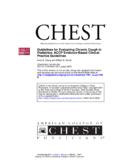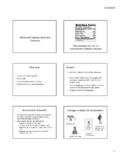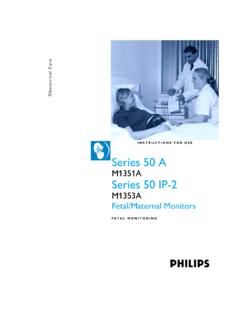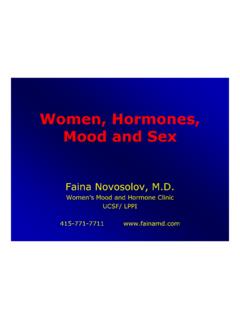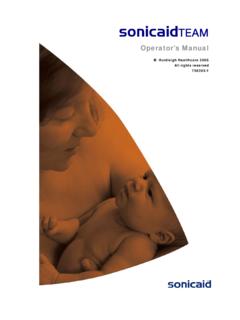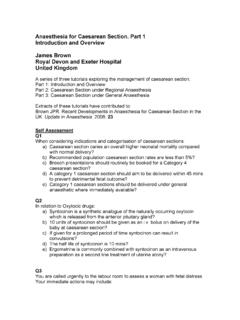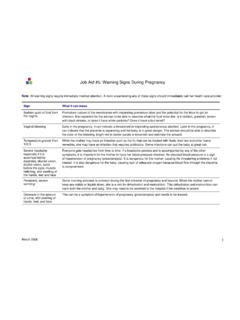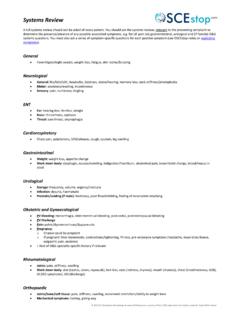Transcription of Classification Systems in Cerebral Palsy - ohsu.edu
1 Classification Systemsin Cerebral PalsySusan A. Rethlefsen,PTa, Deirdre D. Ryan,MDa,b,Robert M. Kay,MDa,b,*The past decade has seen significant progressmade in the evaluation of Cerebral Palsy (CP) andtreatments for its sequelae. Because of advancesin neonatal care and increased survival rates forpreterm and low birth weight infants, efforts arebeing made to document the incidence and prev-alence of CP through registries in Europe andAustralia. Advances in orthopaedic care for chil-dren with CP have also been significant. Comput-erized gait analysis has led to refinements oforthopedic surgeries performed in these event, multilevel surgery is now consideredthe standard of care in areas where gait analysistesting is available.
2 New treatments haveemerged, such as botulinum toxin injection andintrathecal baclofen, to treat spasticity and othertypes of hypertonia of increasing interest in conductinglarge-scale, multicenter investigations into theepidemiology of CP and its prevention and treat-ment, efforts have been made to establish a stan-dard definition and Classification Systems for recent years there has also been increasedfocus on measurement of functional status ofpatients, and new classifications for gross andfine motor function have been purpose of this article is to update the ortho-paedic community on the current classificationsystems for patients with CP. This informationwill be of value to surgeons in determining patients suitability for certain treatments and will also assistthem in reviewing current literature in OF Cerebral PALSYIn 2007, the results of an International Workshopon Definition and Classification of CP were group included experts in the field ofCP and developmental disorders from aroundthe world.
3 The purpose of the workshop was toupdate the existing definition and Classification ofCP to incorporate current knowledge about thedisorder, and to improve communication amongclinicians, researchers and epidemiologists. Thefollowing definition of CP was agreed upon: Cerebral Palsy describes a group of perma-nent disorders of the development of move-ment and posture, causing activity limitation,that are attributed to non-progressive distur-bances that occurred in the developing fetalor infant brain. The motor disorders of cere-bral Palsy are often accompanied by distur-bances of sensation, perception, cognition,communication and behavior, by epilepsy,and by secondary musculoskeletal definition improves upon previous ones byemphasizing that CP involves a variety of disorderscaused by various factors acting at different pointsin fetal development, and also highlights the impor-tance of comorbidities that accompany the ortho-paedic and neurologic manifestations.
4 Thedefinition excludes neurodevelopmental disabilitiesin which movement and posture are unaffected, aswell as progressive disorders of the brain. TheNone of the authors received funding support for the preparation of this Orthopaedic Center, Childrens Hospital Los Angeles, 4650 Sunset Boulevard, MS 69, Los Angeles,CA 90027, USAbKeck School of Medicine, University of Southern California, 1521 San Pablo Street, Los Angeles, CA 90033,USA* Corresponding author. Childrens Orthopaedic Center, Childrens Hospital Los Angeles, 4650 Sunset Boule-vard, MS 69, Los Angeles, CA Cerebral Palsy Classification Impairment Activity limitationOrthop Clin N Am 41 (2010) 457 467 $esee front matter 2010 Elsevier Inc. All rights does not specify an upper age limit foronset of disorders, but inclusion of the phrase fetalor infant implies that it refers to insults occurringbefore full development, before specific milestones,such as walking, would have been remains some disagreement about thisdefinition, but it is generally accepted and beingused.
5 Current issues with it include the lack of defi-nition of an upper limit for age at onset in postna-tally acquired cases, the need for definition ofa lower limit for severity of involvement for acase to be classified as CP, and the need fora decision regarding whether to categorizesyndromes, genetic disorders, or brain abnormal-ities resulting in static encephalopathy as Classification OFFUNCTIONING, DISABILITY, AND HEALTHIn 2001, the World Health Organization publishedthe International Classification of Functioning,Disability, and Health (ICF) for member states touse to standardize health and disability ICF is increasingly being incorpo-rated into research in developmental ICF describes disability as dysfunction at 1or more of 3 levels:impairmentof body structures(organs or limbs) or functions (physiologic orpsychological), limitations inactivities(executionof tasks or actions by the individual), and restric-tion ofparticipation(involvement in life situations).
6 Researchers frequently design studies addressingthese various domains of disability. Currently, Classification schemes exist for CP at both theimpairment and activity limitation levels, and theseare the focus of this article. No classificationsystems exist to date for restriction OF IMPAIRMENTSM otor AbnormalitiesIt has been estimated that about 80% of childrenwith CP have some type of movement is most often classified as either spastic, dyski-netic, or spasticity is often thedominant disorder, many children with CP havemixed spasticity and dystonia. When more than 1type of movement disorder is present in patients,experts recommend classifying patients bythe predominant disorder, for epidemiologicpurposes,1with listing of secondary disorders movement disorders should benoted because this may impact treatment deci-sions.
7 In particular, the results of soft-tissuesurgeries are often less predictable in childrenwith movement most current and comprehensive set ofclassifications for motor disorders has been pub-lished by the Task Force on Childhood ,8 The group is an interdisciplinarypanel of experts in the field of movement disordersand Cerebral Palsy , including pediatric neurolo-gists and neurosurgeons, orthopaedic surgeons,pediatricians, physical and occupational thera-pists, and other specialists. Their aims includedestablishment of definitions and classifications ofmotor disorders, with an ultimate goal of allowingimproved communication among clinicians andresearchers, and improving Classification ofpatients for clinical and research purposes.
8 Todate, definitions have been established for hyper-tonic and hyperkinetic movement disorders, aswell as negative motor signs in is defined as abnormally increasedresistance to externally imposed movement abouta joint. 8 Hypertonicity can be caused by spas-ticity, dystonia, or rigidity (though rigidity is rarein children and not associated with Cerebral Palsy ).SpasticitySpasticity is hypertonia in which resistance topassive movement increases with increasingvelocity of movement (or exhibits a spastic catch),and varies with direction of the movement , and/orrises rapidly above a threshold speed or jointangle. 8 Spasticity is often a component of uppermotor neuron syndrome, along with hyperreflexia,clonus, reflex overflow, positive Babinski sign, andpyramidal distribution weakness (upper extremityextensors, lower extremity flexors).
9 Spasticity iscaused by a hyperactive stretch reflex mechanismand is amendable to treatments, such as botu-linum toxin, baclofen, selective dorsal rhizotomy,and orthopaedic surgery, for resultant contrac-tures or balancing of muscle/tendon forces aboutthe is defined as a movement disorder inwhich involuntary sustained or intermittent musclecontractions cause twisting and repetitive move-ments, abnormal postures, or both. 8 When dys-tonic postures are such that they are present atrest and do not relax upon attempts at passivemovement, they cause hypertonia. Dystonia canalso be classified as hyperkinetic (see thefollowing). Dystonic hypertonia is present in caseswhere the resistance to passive movement doesnot change with changes in speed of passivemovement or joint angle (is present at low andhigh speeds with no spastic catch), may beRethlefsen et al458associated with simultaneous agonist and antago-nist contraction (equal resistance when the direc-tion of passive movement is reversed), the limbtends to return to a fixed involuntary posture,and is triggered or worsened by voluntary move-ments at distant is not associatedwith hyperreflexia and often disappears when thechild is asleep.
10 Because myelination is neededfor development of dystonia, it typically occurslater in life than spasticity (around 5e10 years ofage).4It is postulated that a significant proportion ofpatients with Cerebral Palsy have a secondarycomponent of dystonia, resulting in mixed hyper-tonia. Dystonia is associated with disruption ofthe basal ganglia and therefore is not improvedby selective dorsal rhizotomy. In fact, what waspreviously considered recurrent spasticity afterrhizotomy is now thought to be unrecognized is generally accepted that tendon length-ening and transfer procedures are contraindicatedin cases of dystonia, because of the risk for recur-rence of deformity or development of reversedeformities. Although this is the conventionalwisdom, evidence in the literature is limited.


